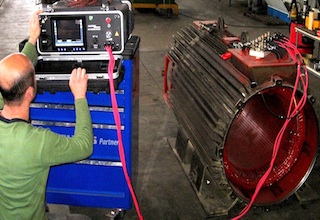The electronic test equipment available today for analyzing electric motors and other devices has become much more powerful. Yet in many instances, these sophisticated devices have also introduced a high degree of complexity for users, requiring that highly trained and experienced personnel perform the testing.
Many of today’s devices are feature rich and capable of measuring and analyzing many variables, including surge comparisons, resistance, impedance and more. Unfortunately, not all of these systems are user friendly, and some can require a substantial investment.
“Today, you can spend up to $100,000 on a winding analyzer,” says Mark Peden, president of Alliance Pump and Mechanical Service in Independence, MO. “But at the same time you could find a very robust model at a much lower price.”
Peden, whose company services utilities including water and wastewater treatment plants, as well as municipal, commercial and industrial pumping equipment, elected to do the latter, investing in a portable winding analyzer and motor tester. Not only was the price less than higher end models, but the system was also user-friendly and easy enough to use that highly trained specialists are not required to operate it.

“We’re a motor shop, which means we clean motors and install or service windings,” Peden explains. “We use an electronic analyzer to test the integrity of the motor windings, to ensure dependable performance.”
The motors that the company services have sometimes been subjected to harsh conditions, including excessive heat, debris, or occasional lightning strikes, all of which mean that windings have to be replaced. When a damaged or simply worn out pump and motor assembly arrives at the shop, Alliance technicians disassemble and thoroughly inspect the motor. The windings are then cleaned, baked and surge tested.
“We have to be certain that the windings are good or six months later a motor could fail, and due to the comprehensive warranty we provide, we’d end up eating the cost of repairing the unit,” Peden explains.
He adds that it takes a good analyzer to do a thorough test on the windings to make sure that the integrity of the motor windings is good. “I looked at several different models, and decided that the iTIG II looked like a pretty user-friendly unit that performed all of the tests and reports that we needed.”
The iTIG II is a winding analyzer and motor tester from Electrom Instruments of Longmont, CO that comes with output ranges from 4kV to 12kV, with optional higher voltage ranges.
“Once we’ve run the analyzer and everything passes there is no doubt that the motor is good. And it also assures the customer that we did comprehensive testing, and that everything checked out,” says Peden. “After the testing the device gives us a printable report that we provide to our customer as documentation of what we found. It’s part of the procedure we follow in motor repair.”
One of the big advantages of some of today’s most advanced instruments is that they are both easy to operate and interpret, but also contain powerful features. The iTIG II gives users the ability to perform a variety of tests from the most simple low resistance tests to Megohm (also called insulation resistance), Hipot and advanced surge testing.
Another key advantage of all iTIG models is that they use a 60-Hz surge pulse frequency. This high pulse rate provides a sufficient frequency to overcome ionization dissipation and can thus isolate insulation weaknesses with more sensitivity, predicting future faults before low frequency testers, and also better simulates motor operating conditions.
The iTIG II lets users enter the surge test voltage, push a button, and let the machine run the test independently. Surge waveform ranges are automatically set for all models, which eliminates the need to specify configurations, push multiple buttons, or turn dials.







Leave a Reply
You must be logged in to post a comment.